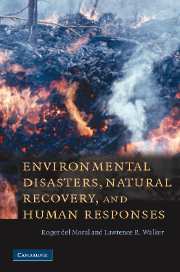Book contents
- Frontmatter
- Contents
- Preface and acknowledgements
- 1 Introduction: a crescendo of destruction
- 2 Natural disturbances: synergistic interactions with humans
- 3 Infertile and unstable habitats
- 4 Infertile and stable habitats
- 5 Fertile and unstable habitats
- 6 Fertile and stable habitats
- 7 The lessons learned
- Glossary
- Illustration credits
- Index
- Plate section
- References
6 - Fertile and stable habitats
Published online by Cambridge University Press: 11 September 2009
- Frontmatter
- Contents
- Preface and acknowledgements
- 1 Introduction: a crescendo of destruction
- 2 Natural disturbances: synergistic interactions with humans
- 3 Infertile and unstable habitats
- 4 Infertile and stable habitats
- 5 Fertile and unstable habitats
- 6 Fertile and stable habitats
- 7 The lessons learned
- Glossary
- Illustration credits
- Index
- Plate section
- References
Summary
INTRODUCTION
Disturbances of fertile, stable habitats are often caused by natural events including fire, hurricanes, intense rainfall events and strong winds or by human activities that include intentionally set fires, agriculture, logging and grazing. Recovery following mild disturbances is normally rapid compared to intensely damaged sites because there is residual soil, vegetation and fauna and because the disturbance was not severe. However, wildfire, strong winds and human actions can lead to dramatic or subtle degradation of ecosystem properties on a site. When these more intense disturbances occur or chronic disturbances cease, the functioning of the system may have changed permanently and a return to productive ecosystems is not assured. The recovery then occurs in a new context, often quite different from that under which the ecosystem developed.
Today, many natural ecosystems across the world are in crisis. It is as if their immune systems have been compromised as combinations of natural and man-made disturbances become increasingly severe. How to manipulate the aftermath of these disturbances without loss of fertility or stability are lessons that silviculture and agriculture can learn from natural processes. Given that world agricultural production contributes about three quarters of global soil erosion, those lessons appear not yet to have been mastered.
How do ecosystems and humans respond to disturbances in stable habitats that cause relatively little loss of fertility?
- Type
- Chapter
- Information
- Environmental Disasters, Natural Recovery and Human Responses , pp. 144 - 177Publisher: Cambridge University PressPrint publication year: 2007



